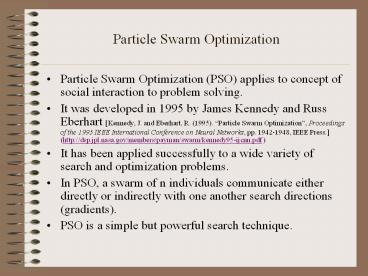Particle Swarm Optimization - PowerPoint PPT Presentation
1 / 13
Title:
Particle Swarm Optimization
Description:
Particle Swarm Optimization Particle Swarm Optimization (PSO) applies to concept of social interaction to problem solving. It was developed in 1995 by James Kennedy ... – PowerPoint PPT presentation
Number of Views:342
Avg rating:3.0/5.0
Title: Particle Swarm Optimization
1
Particle Swarm Optimization
- Particle Swarm Optimization (PSO) applies to
concept of social interaction to problem solving. - It was developed in 1995 by James Kennedy and
Russ Eberhart Kennedy, J. and Eberhart, R.
(1995). Particle Swarm Optimization,
Proceedings of the 1995 IEEE International
Conference on Neural Networks, pp. 1942-1948,
IEEE Press. (http//dsp.jpl.nasa.gov/members/paym
an/swarm/kennedy95-ijcnn.pdf ) - It has been applied successfully to a wide
variety of search and optimization problems. - In PSO, a swarm of n individuals communicate
either directly or indirectly with one another
search directions (gradients). - PSO is a simple but powerful search technique.
2
Particle Swarm OptimizationSwarm Topology
- In PSO, there have been two basic topologies used
in the literature - Ring Topology (neighborhood of 3)
- Star Topology (global neighborhood)
I0
I0
I1
I1
I4
I4
I2
I3
I2
I3
3
Particle Swarm OptimizationThe Anatomy of a
Particle
- A particle (individual) is composed of
- Three vectors
- The x-vector records the current position
(location) of the particle in the search space, - The p-vector records the location of the best
solution found so far by the particle, and - The v-vector contains a gradient (direction) for
which particle will travel in if undisturbed. - Two fitness values
- The x-fitness records the fitness of the
x-vector, and - The p-fitness records the fitness of the
p-vector.
Ik X ltxk0,xk1,,xkn-1gt P
ltpk0,pk1,,pkn-1gt V ltvk0,vk1,,vkn-1gt x_fitness
? p_fitness ?
4
Particle Swarm OptimizationSwarm Search
- In PSO, particles never die!
- Particles can be seen as simple agents that fly
through the search space and record (and possibly
communicate) the best solution that they have
discovered. - So the question now is, How does a particle move
from on location in the search space to another? - This is done by simply adding the v-vector to the
x-vector to get another x-vector (Xi Xi Vi). - Once the particle computes the new Xi it then
evaluates its new location. If x-fitness is
better than p-fitness, then Pi Xi and p-fitness
x-fitness.
5
Particle Swarm OptimizationSwarm Search
- Actually, we must adjust the v-vector before
adding it to the x-vector as follows - vid vid ?1rnd()(pid-xid)
?2rnd()(pgd-xid) - xid xid vid
- Where i is the particle,
- ?1,?2 are learning rates governing the cognition
and social components - Where g represents the index of the particle with
the best p-fitness, and - Where d is the dth dimension.
6
Particle Swarm OptimizationSwarm Search
- Intially the values of the velocity vectors are
randomly generated with the range -Vmax, Vmax
where Vmax is the maximum value that can be
assigned to any vid.
7
Particle Swarm OptimizationSwarm Types
- In his paper, Kennedy, J. (1997), The Particle
Swarm Social Adaptation of Knowledge,
Proceedings of the 1997 International Conference
on Evolutionary Computation, pp. 303-308, IEEE
Press. - Kennedy identifies 4 types of PSO based on ?1 and
?2 . - Given vid vid ?1rnd()(pid-xid)
?2rnd()(pgd-xid) - xid xid vid
- Full Model (?1, ?2 gt 0)
- Cognition Only (?1 gt 0 and ?2 0),
- Social Only (?1 0 and ?2 gt 0)
- Selfless (?1 0, ?2 gt 0, and g ? i)
8
Particle Swarm OptimizationRelated Issues
- There are a number of related issues concerning
PSO - Controlling velocities (determining the best
value for Vmax), - Swarm Size,
- Neighborhood Size,
- Updating X and Velocity Vectors,
- Robust Settings for (?1 and ?2),
- An Off-The-Shelf PSO
- Carlisle, A. and Dozier, G. (2001). An
Off-The-Shelf PSO, Proceedings of the 2001
Workshop on Particle Swarm Optimization, pp. 1-6,
Indianapolis, IN. (http//antho.huntingdon.edu/pub
lications/Off-The-Shelf_PSO.pdf)
9
Particle SwarmControlling Velocities
- When using PSO, it is possible for the magnitude
of the velocities to become very large. - Performance can suffer if Vmax is inappropriately
set. - Two methods were developed for controlling the
growth of velocities - A dynamically adjusted inertia factor, and
- A constriction coefficient.
10
Particle Swarm OptimizationThe Inertia Factor
- When the inertia factor is used, the equation for
updating velocities is changed to - vid ?vid ?1rnd()(pid-xid)
?2rnd()(pgd-xid) - Where ? is initialized to 1.0 and is gradually
reduced over time (measured by cycles through the
algorithm).
11
Particle Swarm OptimizationThe Constriction
Coefficient
- In 1999, Maurice Clerc developed a constriction
Coefficient for PSO. - vid Kvid ?1rnd()(pid-xid)
?2rnd()(pgd-xid) - Where K 2/2 - ? - sqrt(?2 - 4?),
- ? ?1 ?2, and
- ? gt 4.
12
Particle Swarm OptimizationSwarm and
Neighborhood Size
- Concerning the swarm size for PSO, as with other
ECs there is a trade-off between solution quality
and cost (in terms of function evaluations). - Global neighborhoods seem to be better in terms
of computational costs. The performance is
similar to the ring topology (or neighborhoods
greater than 3). - There has been little research on the effects of
swarm topology on the search behavior of PSO.
13
Particle Swarm OptimizationParticle Update
Methods
- There are two ways that particles can be updated
- Synchronously
- Asynchronously
- Asynchronous update allows for newly discovered
solutions to be used more quickly - The asynchronous update method is similar to ____.
I0
I1
I4
I2
I3































